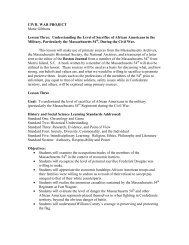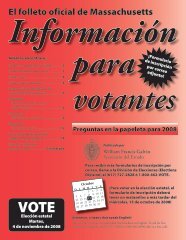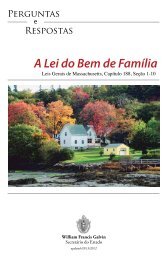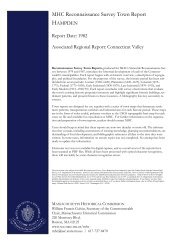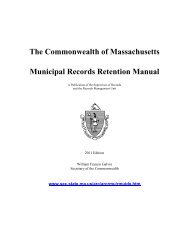Roads, Rails, and Trails - Secretary of the Commonwealth
Roads, Rails, and Trails - Secretary of the Commonwealth
Roads, Rails, and Trails - Secretary of the Commonwealth
You also want an ePaper? Increase the reach of your titles
YUMPU automatically turns print PDFs into web optimized ePapers that Google loves.
49<br />
Route 32 has served as a local trade route linking places<br />
to <strong>the</strong> south <strong>of</strong> Royalston—<strong>the</strong> small city <strong>of</strong> Athol, for<br />
example—with southwestern New Hampshire’s town <strong>of</strong><br />
Richmond <strong>and</strong> city <strong>of</strong> Keene. It was a favorable location for<br />
commerce <strong>and</strong> business; along its length stood blacksmith<br />
shops, gristmills, sawmills, <strong>and</strong>, according to town history, a<br />
tavern.<br />
The Kingsley Tavern was first noted in a narrative by<br />
local historian Linda Caswell, published in <strong>the</strong> town in 1917. It<br />
was said to have been opened around 1800 by one Peleg<br />
Kingsley, <strong>and</strong> run under a succession <strong>of</strong> owners until it closed<br />
in 1826. That for <strong>the</strong> first quarter <strong>of</strong> <strong>the</strong> nineteenth century a<br />
tavern existed in a certain spot along what is now Route 32 had<br />
become an established fact among local residents.<br />
The archaeologists found plenty <strong>of</strong> evidence <strong>of</strong><br />
nineteenth-century activity along Route 32. The nearly 2,000<br />
artifacts <strong>and</strong> several stone foundations attested to occupation<br />
both domestic <strong>and</strong> commercial—a history <strong>of</strong> farmsteads,<br />
blacksmiths, <strong>and</strong> homes—but nothing was found to indicate a<br />
tavern. In particular, kitchen refuse <strong>and</strong> features such as privies<br />
<strong>and</strong> trash pits were notably lacking. There was simply no<br />
archaeological evidence for <strong>the</strong> kinds <strong>of</strong> things one would<br />
associate with a tavern, specifically, large-scale food <strong>and</strong> drink<br />
preparation <strong>and</strong> trash disposal. Moreover, fur<strong>the</strong>r research in<br />
town records, deeds, <strong>and</strong> o<strong>the</strong>r documents found no mention at<br />
all <strong>of</strong> a tavern or restaurant here, apart from Caswell’s<br />
This map <strong>of</strong> Royalston from 1831 (five years after <strong>the</strong><br />
Kingsley Tavern would have closed) shows <strong>the</strong> roads<br />
(highlighted in orange) that would eventually become<br />
Massachusetts Route 32. The black arrows show where<br />
<strong>the</strong> archaeologists tested.



